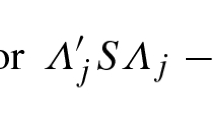Abstract
A new computational method for the maximum likelihood solution in factor analysis is presented. This method takes into account the fact that the likelihood function may not have a maximum in a point of the parameter space where all unique variances are positive. Instead, the maximum may be attained on the boundary of the parameter space where one or more of the unique variances are zero. It is demonstrated that suchimproper (Heywood) solutions occur more often than is usually expected. A general procedure to deal with such improper solutions is proposed. The proposed methods are illustrated using two small sets of empirical data, and results obtained from the analyses of many other sets of data are reported. These analyses verify that the new computational method converges rapidly and that the maximum likelihood solution can be determined very accurately. A by-product obtained by the method is a large sample estimate of the variance-covariance matrix of the estimated unique variances. This can be used to set up approximate confidence intervals for communalities and unique variances.
Similar content being viewed by others
References
Aitchison, J. & Silvey, S. D. Maximum likelihood estimation procedures and associated tests of significance.Journal of the Royal Statistical Society, Series B, 1960,22, 154–171.
Anderson, T. W.An introduction to multivariate statistical analysis. New York: Wiley, 1958.
Bargmann, R. A study of independence and dependence in multivariate normal analysis. University of North Carolina, Institute of Statistics Mimeo Series No. 186, 1957.
Bechtoldt, H. P. An empirical study of the factor analysis stability hypothesis.Psychometrika, 1961,26, 405–432.
Bellman, R.Introduction to matrix analysis. New York: McGraw-Hill, 1960.
Box, G. E. P. A general distribution theory for a class of likelihood criteria.Biometrika, 1949,36, 317–346.
Browne, M. W. A comparison of factor analytic techniques. Master's Thesis, University of Witwatersrand, South Africa, 1965.
Davis, F. B. Fundamental factors of comprehension in reading.Psychometrika, 1944,9, 185–197.
Emmett, W. G. Factor analysis by Lawley's method of maximum likelihood.British Journal of Psychology, Statistical Section, 1949,2, 90–97.
Fletcher, R. & Powell, M. J. D. A rapidly convergent descent method for minimization.Computer Journal, 1963,2, 163–168.
Harman, H. H.Modern factor analysis. Chicago: University of Chicago Press, 1960.
Hemmerle, W. J. Obtaining maximum-likelihood estimates of factor loadings and communalities using an easily implemented iterative procedure.Psychometrika, 1965,30, 291–302.
Howe, W. G. Some contributions to factor analysis. Report No. ORNL-1919, Oak Ridge National Laboratory, Oak Ridge, Tennessee, 1955.
Jöreskog, K. G.Statistical estimation in factor analysis. Stockholm: Almqvist & Wiksell, 1963.
Jöreslkog, K. G. Testing a simple structure hypothesis in factor analysis.Psychometrika, 1966,31, 165–178.
Jöreskog, K. G. UMLFA-a computer program for unrestricted maximum likelihood factor analysis. Research Memorandum 66-20. Princeton, New Jersey: Educational Testing Service. Revised Edition 1967.
Kendall, M. G. & Stuart, A.The advanced theory of statistics, Volume 2. London: Charles Griffin and Co., 1961.
Lawley, D. N. The estimation of factor loadings by the method of maximum likelihood.Proceedings of the Royal Society of Edinburgh, Section A, 1940,60, 64–82.
Lawley, D. N. Further investigations in factor estimation.Proceedings of the Royal Society of Edinburgh, Section A, 1942,61, 176–185.
Lawley, D. N. The application of the maximum likelihood method to factor analysis.British Journal of Psychology, 1943,33, 172–175.
Lawley, D. N. A statistical examination of the centroid method.Proceedings of the Royal Society of Edinburgh, Section A, 1955,64, 175–189.
Lawley, D. N. Some new results in maximum likelihood factor analysis.Proceedings of the Royal Society of Edinburgh, Section A, 1967,67, 256–264.
Lawley, D. N. & Maxwell, A. E.Factor analysis as a statistical method. London: Butterworths, 1963.
Lord, F. M. A study of speed factors in tests and academic grades.Psychometrika, 1956,21, 31–50.
Mattsson, A., Olsson, U., & Rosen, M. The maximum likelihood method in factor analysis with special consideration to the problem of improper solutions. Research Report, Institute of Statistics, University of Uppsala, Sweden, 1966.
Maxwell, E. A. Recent trends in factor analysis.Journal of the Royal Statistical Society, Series A, 1961,124, 49–59.
Neyman, J. & Pearson, E. S. On the use and interpretation of certain test criteria for purposes of statistical inference.Biometrika, 1928,20A, 175–240, 263–294.
Ortega, J. M. On sturm-sequences for tri-diagonal matrices.Journal of the Association of Computing Machinery, 1960,7, 260–263.
Ortega, J. M. & Kaiser, H. F. The LLT and QR methods for symmetric tri-diagonal matrices.Computer Journal, 1963,6, 99–101.
Rao, C. R. Estimation and tests of significance in factor analysis.Psychometrika, 1955,20, 93–111.
Rippe, D. D. Application of a large sampling criterion to some sampling problems in factor analysis.Psychometrika, 1953,18, 191–205.
Wilkinson, J. H. The calculation of eigenvectors of codiagonal matrices.Computer Journal, 1958,1, 90–96.
Wilkinson, J. H. Householder's method for the solution of the algebraic eigenproblem.Computer Journal, 1960,3, 23–27.
Wilks, S. S. The large-sample distribution of the likelihood ratio for testing composite hypotheses.Annals of Mathematical Statistics, 1938,9, 60–62.
Author information
Authors and Affiliations
Additional information
The first part of this work was done at the University of Uppsala, Sweden and supported by the Swedish Council for Social Science Research. The second part was done at Educational Testing Service and supported by a grant (NSF-GB-1985) from National Science Foundation to Educational Testing Service.
The author is deeply indebted to Dr. D. N. Lawley whose contributions amounted nearly to coauthorship. The author also wishes to thank Mr. G. Gruvaeus for much valuable assistance in constructing the computer program.
Rights and permissions
About this article
Cite this article
Jöreskog, K.G. Some contributions to maximum likelihood factor analysis. Psychometrika 32, 443–482 (1967). https://doi.org/10.1007/BF02289658
Received:
Revised:
Issue Date:
DOI: https://doi.org/10.1007/BF02289658




